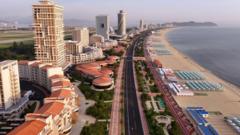Amidst the growing demand for humanoid robots, innovations are flooding in from companies like Unitree and Tesla, with various firms racing to conquer market segments. The challenge remains significant, particularly in integrating AI and ensuring safety for humanoid functions outside controlled environments.
Race for Humanoid Robots: Who Leads the Future?

Race for Humanoid Robots: Who Leads the Future?
As several firms worldwide dive into humanoid robot development, the competition intensifies, with China emerging as a key player.
It’s a bright spring morning in Hanover, Germany, and I’m on my way to meet a robot. The G1, a humanoid robot developed by China's Unitree, is taking center stage at Hannover Messe, one of the largest industrial trade shows worldwide. Standing at 4'3" (130 cm) tall, the G1 stands out for its affordability and impressive dexterity, showcased through viral videos of it dancing and performing martial arts.
Today, remote control of the G1 is in the hands of Pedro Zheng, Unitree's sales manager. He explains that customers need to program each G1 for autonomous functions, as it requires interaction from its operators. Onlookers are drawn in, attempting to engage with the G1, which responds with waves and bows, creating a level of comfort compared to other exhibits that lack such human-like interaction.
Unitree is among numerous global entities venturing into humanoid robotics, regarded as a potential solution offering sustained workforce capabilities devoid of holidays or salaries. Yet, as Zheng points out, the technology is still developing. While robotic arms and mobile bots thrive in controlled factory settings, introducing a humanoid robot into unpredictable environments like homes or restaurants proves significantly more complex.
"There’s still a long way to go for the artificial intelligence that will control such machines," observes a Unitree representative, highlighting the challenges AI faces in executing complex, logical tasks efficiently. Currently, the G1 caters primarily to research institutions and tech firms, allowing them to utilize open-source software for further exploration.
With entrepreneurs pivoting their focus to humanoid robots for industrial use, Tesla's Elon Musk stands as a prominent figure, promising thousands of humanoid robots named Optimus to be operational within Tesla factories this year. Other automotive companies aren’t lagging; BMW has also integrated humanoid robots into its U.S. manufacturing processes, while Hyundai has placed large orders with Boston Dynamics.
According to Thomas Andersson, founder of research firm STIQ, the humanoid robot development landscape comprises 49 leading firms driving innovation and extending to over 100 if broader robotic definitions are considered. Andersson believes Chinese corporations are well-positioned to dominate this technology market due to their extensive supply chain and governmental support, making advancements and iterations more feasible.
However, European and American firms face formidable challenges competing against well-backed Chinese manufacturers. Bren Pierce, a Bristol-based entrepreneur with three robotics ventures, contends that producing humanoid robots in Europe or the USA is unfeasible when most components are sourced from China. This financial burden necessitates manufacturing in Asia to optimize costs.
Pierce’s Kinisi has just released the KR1, designed for industrial settings yet is not a full humanoid robot. By opting for a simpler form without legs, costs are reduced greatly. He aims to utilize mass-produced components to enhance affordability, advocating for practical designs that don’t complicate user interaction.
Despite the advancements, both Pierce and other industry insiders acknowledge that widespread deployment of humanoid robots in everyday settings is likely a longer-term aspiration. "I believe they will eventually make it into homes, but we are still at least a decade away," muses Pierce, emphasizing the complexity involved in developing truly versatile robotics.





















